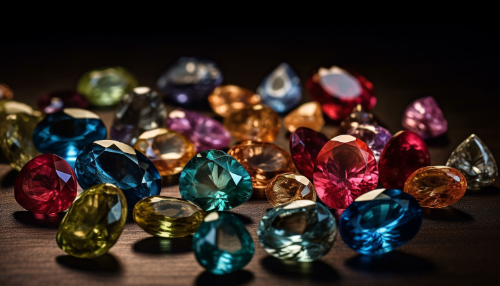
Tourmaline is a name applied to a family of related minerals with widely varying properties. Tourmalines make very popular jewelry stones and comes in an amazing range of colors, like pink, blue, green, yellow, colorless, and black. Stones can also include multi-color zones.
Ready availability keeps tourmaline prices reasonable. Small tourmalines (under 5 carats) are fairly easy to obtain at modest cost. Only when you get into large sizes or extremely rare or fine colors do prices go over a few hundred dollars per carat.
Most colors are fairly common, but pure blue, red, orange, yellow, and purple stones are rare. Such stones usually command higher prices. Color-change tourmalines are also exceptionally rare. Neon-blue paraíba tourmalines, raspberry-red rubellites, and emerald-green chrome tourmalines are especially prized.
Brightly colored Ceylonese gem tourmalines were brought to Europe in great quantities by the Dutch East India Company to satisfy a demand for curiosities and gems. Tourmaline was sometimes called the “Ceylonese Magnet” because it could attract and then repel hot ashes due to its pyroelectric properties.
Tourmalines were used by chemists in the 19th century to polarize light by shining rays onto a cut and polished surface of the gem.

Schori
The most common species of tourmaline is schorl, the sodium iron (divalent) endmember of the group. It may account for 95% or more of all tourmaline in nature. The early history of the mineral schorl shows that the name “schorl” was in use prior to 1400 because a village known today as Zschorlau (in Saxony, Germany) was then named “Schorl” (or minor variants of this name), and the village had a nearby tin mine where, in addition to cassiterite, black tourmaline was found. The first description of schorl with the name “schürl” and its occurrence (various tin mines in the Ore Mountains) was written by Johannes Mathesius (1504–1565) in 1562 under the title “Sarepta oder Bergpostill”. Up to about 1600, additional names used in the German language were “Schurel”, “Schörle”, and “Schurl”. Beginning in the 18th century, the name Schörl was mainly used in the German-speaking area. In English, the names shorl and shirl were used in the 18th century. In the 19th century the names common schorl, schörl, schorl and iron tourmaline were the English words used for this mineral.

Dravite
Dravite, also called brown tourmaline, is the sodium magnesium rich tourmaline endmember. Uvite, in comparison, is a calcium magnesium tourmaline. Dravite forms multiple series, with other tourmaline members, including schorl and elbaite.
The name dravite was used for the first time by Gustav Tschermak (1836–1927), Professor of Mineralogy and Petrography at the University of Vienna, in his book Lehrbuch der Mineralogie (published in 1884) for magnesium-rich (and sodium-rich) tourmaline from village Dobrova near Unterdrauburg in the Drava river area, Carinthia, Austro-Hungarian Empire. Today this tourmaline locality (type locality for dravite) at Dobrova (near Dravograd), is a part of the Republic of Slovenia. Tschermak gave this tourmaline the name dravite, for the Drava river area, which is the district along the Drava River (in German: Drau, in Latin: Drave) in Austria and Slovenia.
Dravite varieties include the deep green chromium dravite and the vanadium dravite.

Ebalite
A lithium-tourmaline elbaite was one of three pegmatitic minerals from Utö, Sweden, in which the new alkali element lithium (Li) was determined in 1818 by Johan August Arfwedson for the first time. Elba Island, Italy, was one of the first localities where colored and colorless Li-tourmalines were extensively chemically analysed. In 1850, Karl Friedrich August Rammelsberg described fluorine (F) in tourmaline for the first time. In 1870, he proved that all varieties of tourmaline contain chemically bound water.
Color
Tourmaline has a variety of colors. Iron-rich tourmalines are usually black to bluish-black to deep brown, while magnesium-rich varieties are brown to yellow, and lithium-rich tourmalines are almost any color: blue, green, red, yellow, pink, etc. Rarely, it is colorless. Bi-colored and multicolored crystals are common, reflecting variations of fluid chemistry during crystallization. Crystals may be green at one end and pink at the other, or green on the outside and pink inside; this type is called watermelon tourmaline and is prized in jewelry. An excellent example of watermelon tourmaline jewelry is a brooch piece (1969, gold, watermelon tourmaline, diamonds) by Andrew Grima (British, b. Italy, 1921–2007), in the collection of Kimberly Klosterman and on display at the Cincinnati Art Museum. Some forms of tourmaline are dichroic; they change color when viewed from different directions.
The pink color of tourmalines from many localities is the result of prolonged natural irradiation. During their growth, these tourmaline crystals incorporated Mn2+ and were initially very pale. Due to natural gamma ray exposure from radioactive decay of 40K in their granitic environment, gradual formation of Mn3+ ions occurs, which is responsible for the deepening of the pink to red color.
In Our Shop
Sources
International Gem Society
Wikipedia

